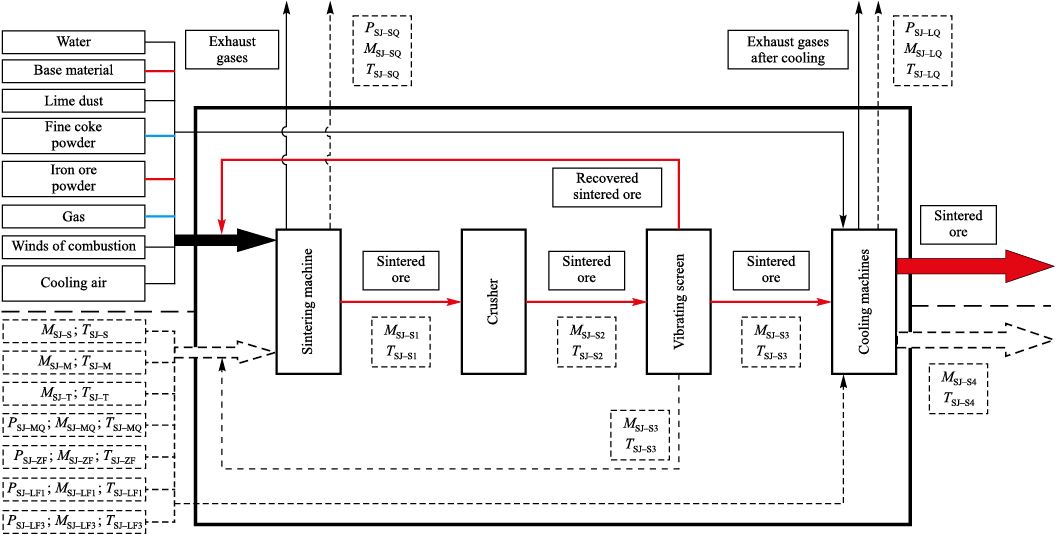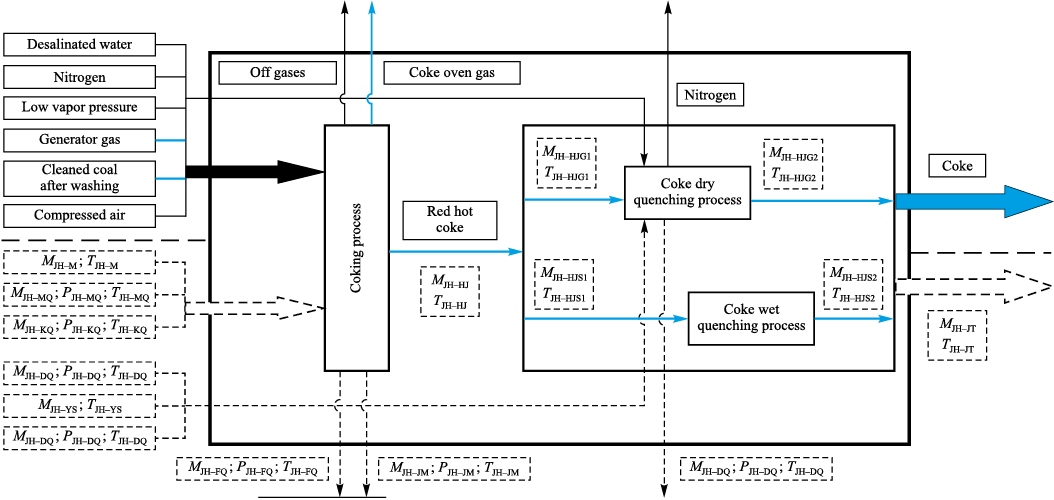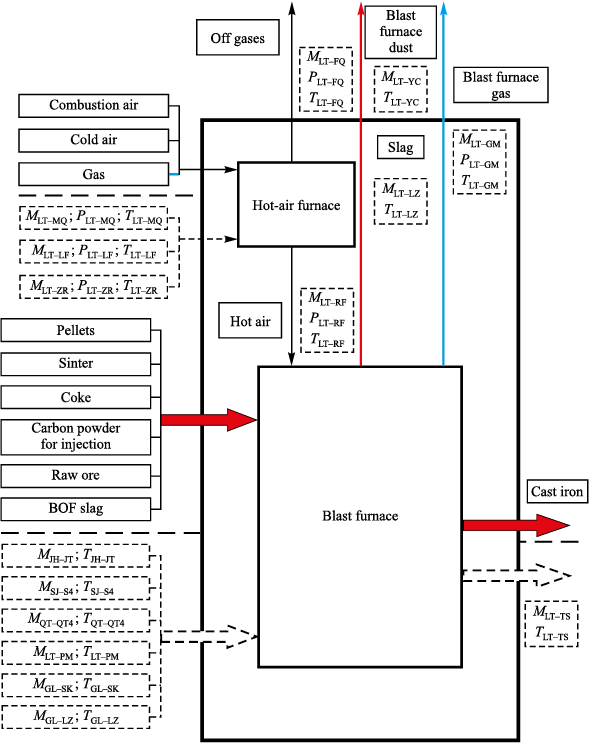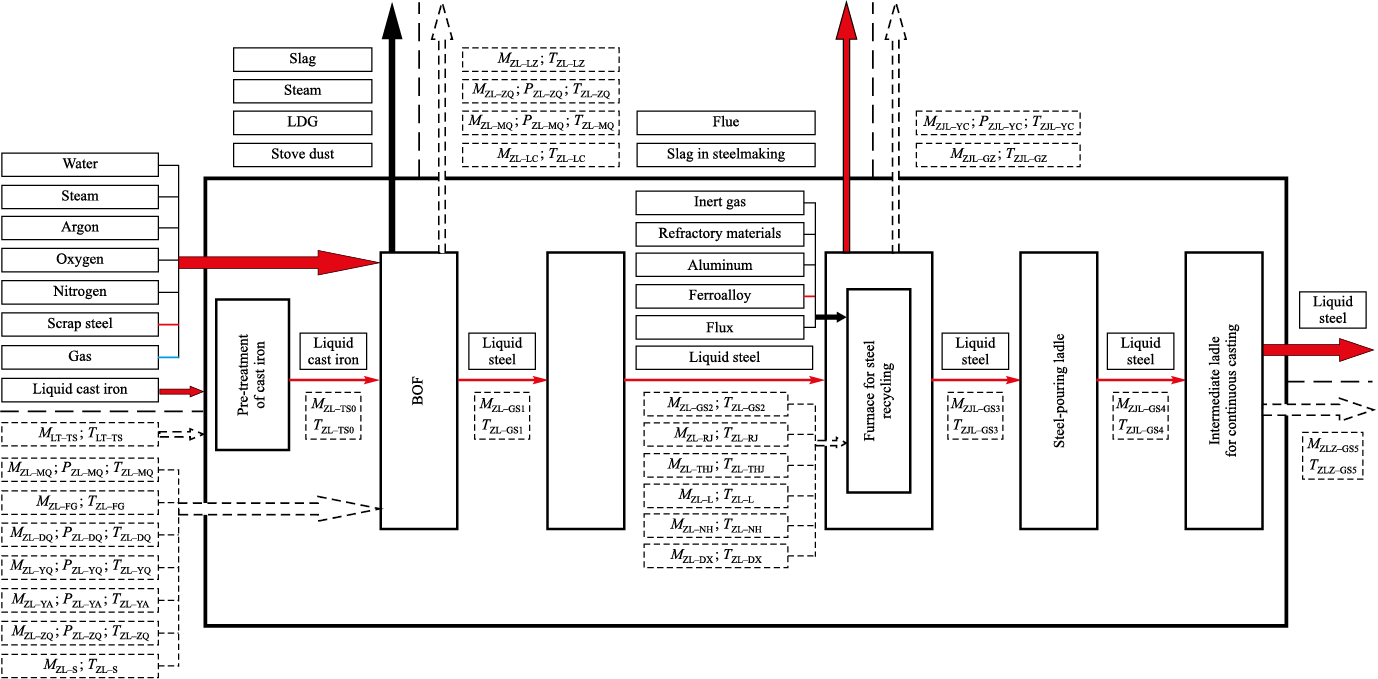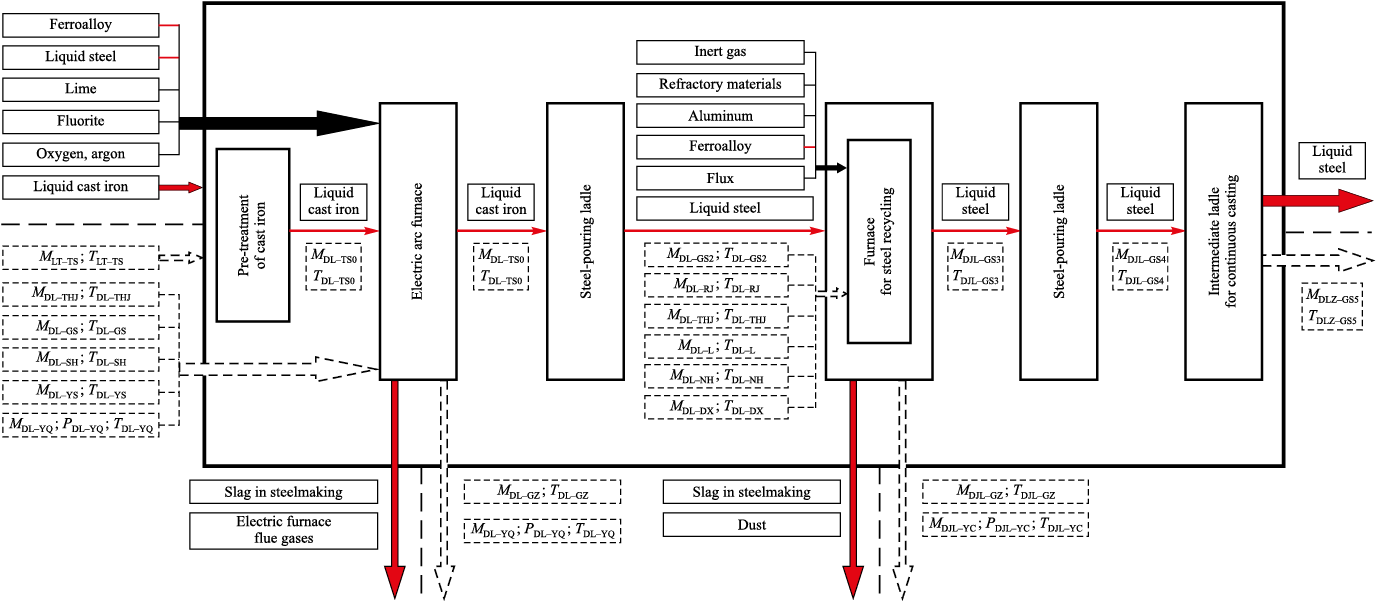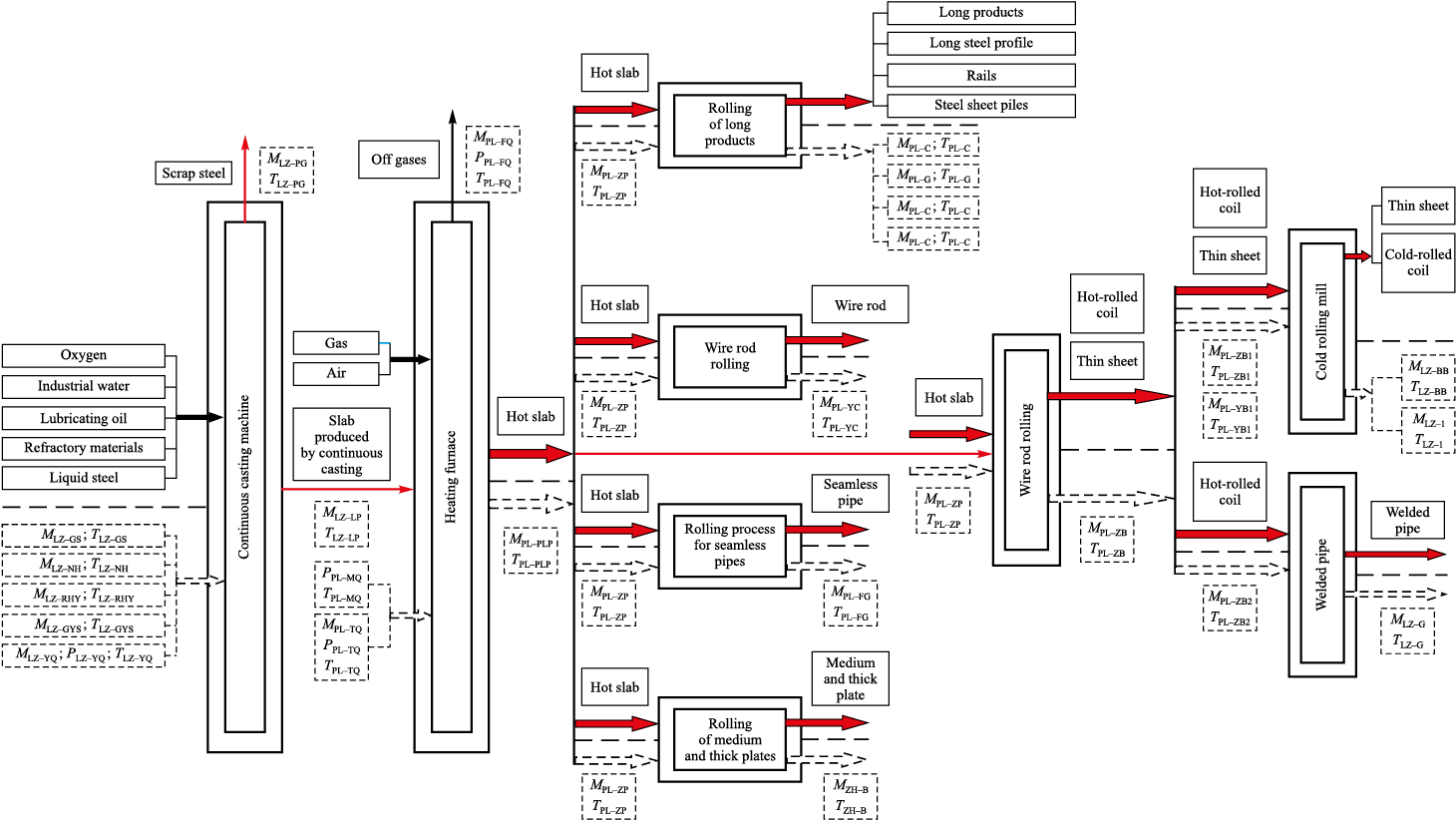Scroll to:
Energy saving model for related processes in steelmaking
https://doi.org/10.17073/0368-0797-2024-3-270-282
Abstract
In the development of advanced energy saving technologies in the metallurgical industry, a comprehensive approach to managing energy flows is crucial. This article presents an in-depth analysis of the steelmaking and metallurgical industry in China and Russia, focusing on the evolution and current shortcomings of energy saving methods in metallurgical processes. The authors thoroughly analyze various technological processes, including sintering, coking, pellet production, iron production in blast furnaces, steel production in oxygen converters and electric arc furnaces, as well as steel rolling, identifying significant potential for enhancing energy efficiency and reducing harmful emissions. The main outcome of the research is the development of structural models of technological processes based on the concept of energy saving “temperature matching, cascade utilization, and global linkage”, covering key stages of steelmaking. These models provide detailed descriptions of the role and interrelation of each process within the complete metallurgical cycle and combine into a comprehensive structural model of steelmaking technological process. The model includes not only specific operations and characteristics of each stage but also explains how these processes interact and depend on each other, forming an integrated and interconnected system of metallurgical production. This model encompasses comprehensive temperature-pressure and production links, providing a theoretical basis for the development of mathematical models of energy saving and the design of corresponding computer applications. The structural model of steelmaking technological process is important for understanding and optimizing the entire process of metallurgical production, contributing to its energy and ecological efficiency.
Keywords
For citations:
Wang W., Li S., Xu W., Chikova O.A., Zhang Y. Energy saving model for related processes in steelmaking. Izvestiya. Ferrous Metallurgy. 2024;67(3):270-282. https://doi.org/10.17073/0368-0797-2024-3-270-282
Introduction
Steelmaking is the key sector of China’s national economy, it determines the development of major industries and the state’s competitiveness in world markets. In 2017, the volume of steel produced by China three times exceeded that manufactured by the US, Russia and Japan combined. Steel has propelled China’s shipbuilding and automobile industries to the top of the global market [1]. Steelmaking is characterized by long production cycles and high energy consumption. Meanwhile, steel production is a dangerous source of atmospheric pollution by off gases and solid emissions, which contain various toxic substances. Energy saving and emission reduction in steelmaking are crucial for China’s national economy [2]. Back in 2014, Chinese President Xi Jinping formulated the main principles of China’s new energy strategy FROCSV (Four Revolutions and One Cooperation Strategic Vision), including the energy consumption reform that involves energy efficiency improvement [1]. China’s iron and steel industry has made significant progress in enhancing energy efficiency – the average intensity of total energy consumption at major steel plants has decreased. An evaluation framework has been developed to quantify the energy and environmental benefits (i.e., CO2 and air-pollutants emission reduction and water savings) associated with 36 energy-efficiency measures [3]. The key topic of the 2011 – 2025 research on energy savings is the synergistic operation of material and energy flows [4] based on the energy saving model for China’s iron and steel industry IECUA (Industrial Energy Conservation Uncertainty Analysis) [5].
At present, Russia actively uses modern energy- and resource-saving environmentally friendly technologies in steel production, so the analysis of the Chinese researchers’ experience in this matter is especially important [6]. Low energy consuming metallurgical technologies (continuous casting of steel, evaporative cooling, etc.) are introduced [7]. The technology of dry granulation of slag using its physical heat developed by Russian metallurgical scientists is applied at metallurgical plants in China [8]. An energy-efficient environmentally friendly technology of injecting hot reducing gases into the blast furnace (blast furnace gas recycling) has been developed and introduced [9]. There are only two routes of steel production: blast furnace – basic oxygen furnace (BF – BOF) and electric arc furnace (EAF) [10]. China and Russia use the BF – BOF route as their main route of steel production [11], so our countries can share their best practices. In China, energy efficiency (EI) in steel production is achieved by applying energy-saving and secondary energy-recovery technologies such as:
– use of waste heat and LDG;
– comprehensive utilization of steelmaking waste [11];
– widespread use of energy-saving technologies reducing emissions CO2 [12].
On the BF – BOF route, material and energy flows are closely linked, enabling the iron-containing materials and energy to move and transform [13]. Chinese scientists have developed structural models of energy flows within the IDDD+N concept (Integration of the processes, Differentiation of the demand, Diversification of the supply, Decentralization of the grid, and Network of multi-energy flows) aimed at optimizing the energy use, integrating the technological processes and decentralizing the production management [14]. The structural model of energy flows includes systems for heat conversion, utilization, and recovery, as well as energy buffering and storage. In fact, metallurgical plants produce and consume energy at the same time: BFs consume coal and produce coke and coke oven gas (COG), BOFs consume electricity and oxygen and produce Linz-Donawitz Gas (LDG) [15], i.e., they are prosumers [16]. Mathematical modeling enables to conduct a quantitative study of structural models for energy saving [10; 17], in particular, the specialized software METSIM and SYSCAD provides for calculating the heat/material balance [18]. The authors of [19; 20] note that structural models of energy flows should take into account the interactions and synergy between material and energy flows. Recently, the concept of smart steel manufacturing as part of Industry 4.0 built on cyber-physical systems (CPS) has become popular [21 – 24]. Decarbonization of the metallurgical industry is a pressing task [25], researchers are currently focused on developing carbon capture and storage (CCS) technologies [26].
Chinese scientists have created a conceptual model linking the material, energy and emission flows along the BF – BOF route, including byproduct cokemaking, sinter production and iron founding, where by-product gases are used as fuel, the surplus being transferred to power plants for energy generation [27]. The model involves macro-grid control of the steel production process considering the interrelation of the material, energy and information flows to achieve “minimum” emissions, as well as of energy and materials consumption [28]. Lu Zhongwu proposed the concept of linked saving of energy and materials for the metallurgical industry [29]. Based on the phenomenological model of substance (iron) flow in the technological cycle of steel production, a system of equations was obtained to calculate the indexes of substance flow and the relationship between them [30]. Yin Ruiyu proposed a series of measures of energy-saving and emission reduction based on the mechanism of ferrogenious flow and carbon energy flow system. His concept involves “buying coal only, not electricity or fuel” and achieving “zero emissions” of by-product gases and other energy mediums [31]. Yin Ruiyu established a dynamic integration for the “mass – energy – time – space – information” during the steel manufacturing process based on analyzing the basic elements and characteristics of the processes [32]. Yongqi Sun, Zuotai Zhang developed a blast furnace slags (BFS) and steel slags (SS) disposal model based on the integration of heat recovery and material recycling and crystallization control of the slags [33]. A mind map of the integration of material and energy flows at steel plants was developed [34]. The paper [35] presents an analytical review of publications on decarbonization of iron and steel industry in the context of financial, organizational and behavioral aspects. Numerous works by Chinese researchers on the interrelation of material and energy flows for the sintering process are noteworthy [36 – 38]. The exergy analysis in steelmaking serves as a theoretical basis for energy saving because exergy accounting of energy and material flows provides an integrated measure of resources, products and wastes at different aggregation levels, from single unit operations and upstream production steps to steel plants and production routes, and exergy indicators can be easily linked to techno-economic ones [39].
Russia has also adopted a similar energy saving model for linked steelmaking processes, which includes the following combined energy saving methods for metallurgical processes: enhancing the blast furnace productivity by implementing the technologies of injecting hot reducing gas and replacing quality ores with siderite ore concentrate (SOC); using CO2 washed from the blast furnace gas in refrigerating equipment; full recovery of LDG heat for SOC roasting [40].
Research methodology
The integration of several scientific approaches – systematic, analytical and comparative – forms the theoretical and methodological basis of the conceptual model of energy saving for the linked processes of steelmaking. It enabled us to explore the main aspects of the problem and the tasks set, to reveal new trends of energy saving for the linked processes of steelmaking and quality indicators of energy saving. We used the methods of theoretical and methodological analysis (comparative, retrospective, and model), comparative analysis of scientific literature, methods for systematizing the authors’ experience in the energy saving organization to identify the main trends in the development of the concept of “linked processes” in the context of energy and materials saving management and environmental safety in the steelmaking industry.
We conducted a conceptual study of the methods of linked reduction of energy consumption in steel production processes based on the principle of cascading energy use and analysis of the causes of energy consumption surges. To enhance energy efficiency, new methods for network energy distribution and coupled energy reduction in steel production processes are proposed. The objective of the work is to develop temperature, pressure and industry coupling models for energy saving in linked steelmaking processes based on the principles of “correspondence of temperatures, cascading use and global coupling”. We developed structural models of technological processes of sintering, coking, pellet manufacture, cast iron production in a blast furnace, iron production in a BOF and an electric furnace, and steel rolling combined into a structural model of steelmaking technological process.
Research results
We will consider sintering and coking processes as study objects. The structural model of sintering (Fig. 1) includes a sintering machine, a cooler, as well as crushing, screening and mixing equipment. The iron-containing material is turned into sinter, which is sent to the blast furnace after cooling. High temperature off gases are used to recover the residual heat. The structural model of the coking process (Fig. 2) includes formation of coke column and quenching technologies. The input materials are turned into red hot coke, which is sent after cooling to the hopper or returned to the raw material cycle. COG and off gases, as well as hot nitrogen from the coke quenching process, are directed to heat recovery and energy saving.
Fig. 1. Model of sintering process
Fig. 2. Model of coking process |
Our study objects are the processes of pellet and cast iron production. The structural model of pellet production (Fig. 3) includes a stirrer, a granulator, a sorting device, a сhain lattice conveyor, a circulating furnace and a cooler. Green pellets are formed from the powdered concentrate and binders and, after sintering and cooling, are sent to the blast furnace or returned for processing. The cold exhaust air is used for energy saving. The structural model of the cast iron production (Fig. 4) includes a blast furnace and an air heater. A blast furnace produces cast iron from sinter, coke, pellets and lump iron ore with the addition of air. Off gases and slag are used for further recovery and energy saving.
Fig. 3. Model of pellet production
Fig. 4. Model of iron production |
For the purpose of the study, let us consider the processes of steelmaking in a BOf and in an electric furnace. The structural model of steel production in a BOF (Fig. 5) includes cast iron pretreatment equipment, a BOF, a ladle for steel transfer, a secondary treatment unit and a ladle for pouring steel. Output materials include steel, slag, LDG and dust. The waste is used for heat and energy recovery. The structural model of steel production in an electric furnace (Fig. 6) includes cast iron pretreatment equipment, an electric furnace, a ladle for transfer, a secondary treatment unit and a ladle for pouring. The input and output materials are similar to the converter process. The waste is also used for heat and energy recovery.
Fig. 5. Model of steelmaking in a converter
Fig. 6. Model of steelmaking in an electric furnice |
As an object of study, let us consider the process of steel rolling and create a structural model of this technological process (Fig. 7). The main equipment of the rolling process includes continuous casting machines, heating furnaces, hot and cold rolling mills. In the steel rolling process model, the input materials include steel, oxygen, water, lubricants, refractory materials, gas and combustion air. The input materials first pass through a continuous casting machine where they are solidified and cast into cast blanks. Then, after heating in the furnace, the blanks are sent to various rolling shops for processing into products of various types (profiles, rods, rails, seamless pipes, sheets or strips). In this case, off gases generated in the heating furnaces are considered in the structural model (Fig. 8) as a direction of leaving the operational framework of the rolling process for residual heat recovery and energy saving.
Fig. 7. Model of steel rolling process |
At the final stage, the structural models of technological processes of sintering, coking, pellet manufacture, cast iron production in a blast furnace, iron production in a BOf and an electric furnace, and steel rolling were combined into a structural model of the steelmaking technological process (Fig. 8).
Рис. 8. Structural model of technological process of steelmaking: |
Using the basic principles of linked energy saving, cascading energy use and loss minimization, we proposed the models of thermal coupling, pressure coupling and inter-branch coupling for separate technological processes of steelmaking – sintering, coking, pellet manufacturing, сast iron production in a blast furnace, iron production in a BOF and an electric furnace, and steel rolling (Fig. 8). Thermal coupling means linking the process where excessive heat is produced to the processes that consume heat in order to provide the best match between heat production and consumption in each process, thereby reducing dependence on external heat sources and enhancing energy efficiency throughout the metallurgical process. In pressure-coupled processes, the excessive pressure produced is transferred to processes with suitable pressure in order to achieve the best possible match between heat energy supply and consumption in each process and thereby reduce pressure supply from external sources and enhance the energy efficiency of the entire metallurgical process. Industry coupling involves linking surplus materials and energy in steel production to customers in other industries where they can be applied to improve materials and energy efficiency. Energy saving through industry coupling is realized by transferring excessive materials and energy of the metallurgical process to related industries, establishing a link between the metallurgical industry and other industries to ensure the interrelation of materials and energy supply in order to enhance the efficiency of the materials and energy use.
Discussion of the research results
This paper presents a conceptual structural model of temperature, pressure and industry coupling for energy saving in linked steelmaking processes. The model is based on the principles of temperature matching, cascading use, and global coupling. In contrast to the matrix model of the interrelation of material, energy and emission flows for the ferrous metallurgy enterprise [26], the presented model is universal in relation to individual technological processes of ferrous metallurgy, it reflects thermal, pressure and industry coupling and allows for an optimized steel production process based on material and energy saving and emission reduction. Lu Zhongwu [28; 29] investigated the effect of logistics on energy and iron consumption during steel production. He found that taking iron-containing materials out of the production process causes an increase in energy and iron consumption per 1 ton of material. Circulation of iron-containing materials within the same process or between processes does not affect the iron consumption per 1 ton, but results in increased energy consumption per 1 ton of material. Consequently, circulation of iron-containing materials should be minimized as much as possible, which is reflected in the modeling rules. Lu Zhongwu [30] used Lagrange and Euler methods to describe fluid flow. He also explained a material flow tracking model based on the iron flow diagram in the life cycle of steel products, which provided a reference for creating and optimizing downstream metallurgical processes. Yin Ruiyu [31] described the behavior models of iron and carbon-energy flows during steel production. He analyzed the potential for energy saving and emission reduction in the steel industry, optimization of metallurgical processes being one of the effective methods. Yin Ruiyu [32] proposed a theoretical approach to creating a new generation of steelmaking processes based on the interaction and synergy of materials, energy and information flows during the metallurgical process. Based on the research of the material and energy flows in steel making processes, combined with the rules of metallurgical process modeling and the real conditions of metallurgical engineering, we developed a technique for designating the material and energy flows and created a structural model of the whole metallurgical production process. In addition to considering material and energy flows, this model includes coupled pressure and temperature conversion and industry integration. The mode takes into account the individual metallurgical processes and emphasizes the interaction between them, which greatly improves energy saving and emission reduction. The qualitative description of a similar energy saving model for linked steelmaking processes in Russia was presented, which includes a number of combined energy-saving methods for metallurgical processes [40].
Conclusions
The paper investigates the key energy saving aspects and trends in steelmaking in both China and Russia. The analysis of various processes, including sintering, coking, pellet manufacturing, cast iron production in a blast furnace, iron production in a BOf and/or an electric furnace, and steel rolling, revealed significant potential for enhancing energy efficiency and reducing emissions.
The main finding of this study is that minimum energy and material consumption, as well as emission reductions, can be achieved by creating a new concept of coupling energy saving with the technological process: “temperature matching, cascading use, and global coupling.” The linked processes in steelmaking are complex processes of continuous and discrete changes in energy and material flows. The model of interrelation of material and energy flows is a restrained model of linked process nodes for ensuring energy and material savings and monitoring emissions. We developed structural models of technological processes covering the key stages of the steelmaking process, including sintering, coking, pellet manufacturing, cast iron production in a blast furnace, iron production in a BOf and an electric furnace, and steel rolling. These models provide detailed descriptions of the role and interrelations of each process within the complete metallurgical cycle and combine into a structural model of steelmaking technological process. The structural model of steel production process reflects the system of interrelations of all metallurgical production stages. Not only does it include the specific operations and characteristics of each stage, but also explains how these processes interact and depend on each other, forming an integrated and interconnected system of metallurgical production. The structural model of steelmaking process is important for understanding and optimizing the entire process of metallurgical production, contributing to its energy and ecological efficiency.
References
1. Zhong C., Zhao Q. Energy efficiency management in China’s steel industry. StudNet. 2021;4(5). (In Russ.).
2. Cai J.J., Sun W.Q. Systems energy conservation and scientific energy utilization of iron and steel industry in China. Iron and Steel. 2012;47(5):1–8.
3. Ma D., Chen W., Xu T. Quantify the energy and environmental benefits of implementing energy-efficiency measures in China’s iron and steel production. Future Cities and Environment. 2015;1:1–7. https://doi.org/10.1186/s40984-015-0005-8
4. Sun W.Q., Cai J.J., Zhu Y. Advances in energy conservation of China steel industry. The Scientific World Journal. 2013;2013(2):247035. https://doi.org/10.1155/2013/247035
5. Wen Z.G., Wang Y.H., Zhang C.K., Zhang X.L. Uncertainty analysis of industrial energy conservation management in China’s iron and steel industry. Journal of Environmental Management. 2018;225:205–214. https://doi.org/10.1016/j.jenvman.2018.07.096
6. Chernobrovin V.P. Ferrous metallurgy in Russia in dynamics (1970–2018). Vestnik Yuzhno-Ural’skogo gosudarstvennogo universiteta. Seriya: Metallurgiya. 2020;20(1): 7–17. (In Russ.).
7. Druzhinin G.M., Zainullin L.A., Kazyaev M.D., Spirin N.A., Yaroshenko Yu.G., Gubinskii M.V. Main directions of resource and energy saving in ferrous metallurgy. In: Creative Heritage of V.E. Grum-Grzhimailo: History, Current State, Future. Proceedings of the Int. Sci. and Pract. Conf. Vol. 1. Yekaterinburg: UrFU; 2014:205–212. (In Russ.).
8. Zajnullin L.A., Druzhinin G.M., Butkarev A.A. Innovative developments of JSC “VNIIMT” for energy saving and ecology in metallurgy. In: Creative Heritage of V.E. Grum-Grzhimailo: History, Current State, Future. Proceedings of the Int. Sci. and Pract. Conf. Vol. 1. Yekaterinburg: UrFU; 2014:235–240. (In Russ.).
9. Shevelev L.N., Brodov A.A. Energy saving, increasing energy efficiency and reducing greenhouse gas emissions in the Russian ferrous metallurgy. Ferrous Metallurgy. Bulletin of Scientific, Technical and Economic Information. 2018;1(2):3–6. (In Russ.).
10. Sun W.Q., Wang Q., Zhou Y., Wu J.Z. Material and energy flows of the iron and steel industry: Status quo, challenges, and perspectives. Applied Energy. 2020;268:114946. https://doi.org/10.1016/j.apenergy.2020.114946
11. He K., Wang L., Li X.Y. Review of the energy consumption and production structure of China’s steel industry: Current situation and future development. Metals. 2020;10(3):302. https://doi.org/10.3390/met10030302
12. Wang P., Morten R., Yang Y., Feng K.S., Kara S., Hauschild M., Chen W.Q. Efficiency stagnation in global steel production urges joint supply- and demand-side mitigation efforts. Nature Communications. 2021;12(1):2066. https://doi.org/10.1038/s41467-021-22245-6
13. Yin R.Y. Theory and Methods of Metallurgical Process Integration. Academic Press; 2016:336.
14. Yang L., Li Z., Hu H., Zou Y., Feng Z., Chen W., Chen F., Wang S., Guo Y. Evaluation of energy utilization efficiency and optimal energy matching model of EAF steelmaking based on association rule mining. Metals. 2024;14(4):458. https://doi.org/10.3390/met14040458
15. Jović M., Laković M., Banjac M. Improving the energy efficiency of a 110 MW thermal power plant by low-cost modification of the cooling system. Energy Environ. 2018;29(2): 245–259. https://doi.org/10.1177/0958305X17747
16. Zhou Y., Wu J., Long C. Evaluation of peer-to-peer energy sharing mechanisms based on a multiagent simulation framework. Applied Energy. 2018;222:993–1022. https://doi.org/10.1016/j.apenergy.2018.02.089
17. Valsalam R., Krishnan N., Muralidharen V. Energy management and control system for integrated steel plants. In: National Convention on Computerisation and Automation in Steel Industry. 1996;2:59–83.
18. Zhao Q.Y., Zhang T.A., Lv G.Z., Zhu X.F., Liu Y. Application of process simulation software METSIM in metallurgy. TELKOMNIKA. 2012;10(8):2202–2208.
19. Yu Q.B., Lu Z.W., Cai J.J. Calculating method for influence of material flow on energy consumption in steel manufacturing process. Journal of Iron and Steel Research International. 2007;14(2):46–51. https://doi.org/10.1016/S1006-706X(07)60026-0
20. Na H., Du T., Sun W., He J., Sun J., Yuan Y., etc. Review of evaluation methodologies and influencing factors for energy efficiency of the iron and steel industry. International Journal of Energy Research. 2019;43(11):5659–5677. https://doi.org/10.1002/er.4623
21. Cicconi P., Russo A.C., Germani M., Prist M., Pallotta E., Monteriù A. Cyber–physical system integration for industry 4.0: Modelling and simulation of an induction heating process for aluminum-steel molds in footwear soles manufacturing. In: 2017 IEEE 3rd Int. Forum on Research and Technologies for Society and Industry. Modena: IEEE; 2017:1–6.
22. Haag S., Anderl R. Digital twin – Proof of concept. Manufacturing Letters. 2018;15(B):64–66. https://doi.org/10.1016/j.mfglet.2018.02.006
23. Zhao H.T., Jiang P., Chen Z., Ezeh C.I., Hong Y.D., Guo Y.S., Zheng C.H., Hrvoje D., Gao X., Wu T. Improvement of fuel sources and energy products flexibility in coal power plants via energy–cyber–physical–systems approach. Applied Energy. 2019;254:113554. https://doi.org/10.1016/j.apenergy.2019.113554
24. Al-Wakeel A., Wu J., Jenkins N. State estimation of medium voltage distribution networks using smart meter measurements. Applied Energy. 2016;184:207–218. https://doi.org/10.1016/j.apenergy.2016.10.010
25. Gao C., Gao W., Song K., Na H., Tian F., Zhang S. Spatial and temporal dynamics of air-pollutant emission inventory of steel industry in China: A bottom-up approach. Resources, Conservation & Recycling. 2019;143:184–200. https://doi.org/10.1016/j.resconrec.2018.12.032
26. Griffin P.W., Hammond G.P. Industrial energy use and carbon emissions reduction in the iron and steel sector: A UK perspective. Applied Energy. 2019;249:109–125. https://doi.org/10.1016/j.apenergy.2019.04.148
27. Sun W.Q., Wang Q., Zheng Z., Cai J.J. Material–energy–emission nexus in the integrated iron and steel industry. Energy Conversion and Management. 2020;213:112828. https://doi.org/10.1016/j.enconman.2020.112828
28. Lu Z.-W., Cai J.-J., Yu Q.-B. The influences of materials flow in steel manufacturing process on its energy intensity. Acta Metallurgica Sinica(China). 2000;36(4):370–378.
29. Lu Z.-W., Dai T. Influence of material flow in steel manufacturing process on energy consumption and metal yield. Iron and Steel. 2005;(4):1–7.
30. Lu Z.-W. The following-observing method for substance flow analysis. Engineering Science. 2006;8(1):18–25.
31. Yin R.Y. The energy flow behavior and energy flow network in steel manufacturing process. Journal of Engineering Studies. 2010;2(1):1–4.
32. Yin R.Y. Theory and Methods of Metallurgical Process Integration. Academic Press; 2016:336.
33. Sun Y.Q., Zhang Z.T. Disposal of high-temperature slags: A review of integration of heat recovery and material recycling. Metallurgical and Materials Transactions E. 2016;3: 114–122. https://doi.org/10.1007/s40553-016-0075-z
34. Gu Y., Liu W., Wang B., Tian B., Yang X., Pan C. Analysis and prediction of energy, environmental and economic potentials in the iron and steel industry of China. Processes. 2023;11(12):3258. https://doi.org/10.3390/pr11123258
35. Jinsoo K., Benjamin K.S., Morgan B., Steve G., Junghwan L., Minyoung Y., Jordy L. Decarbonizing the iron and steel industry: A systematic review of sociotechnical systems, technological innovations, and policy options. Energy Research & Social Science. 2022;89:102565. https://doi.org/10.1016/j.erss.2022.102565
36. Jia F.R., Wang E.G., He J.C., Dong H., Zhao Y.D. Waste heat recovery and utilization during sintering process. Industrial Heating. 2014;43(4):45–48.
37. Yang B., Chen L.G., Shen X., Qin X.Y., Sun F.R. Current status and case study on sintering process waste heat recovery and utilization in China. Research on Iron and Steel. 2014;42(4):54–57.
38. Liu W.C., Cai J.J., Dong H., Zhang Q., Qi G.C. Thermodynamic analysis on the effective recovery and utilization of sinter waste heat. China Metallurgy. 2013;23(2):15–20.
39. Costa M.M., Schaeffer R., Worrell E. Exergy accounting of energy and materials flows in steel production systems. Energy. 2001;26(4):363–384. https://doi.org/10.1016/S0360-5442(01)00004-4
40. Sergeev P.A., Neshporenko E.G. Analysis of the effective use of energy-saving technologies at a metallurgical enterprise. Sovremennye innovatsii. 2015;(2(2)):27–30. (In Russ.).
About the Authors
W. WangChina
Weishu Wang, Dr. Sci. (Energy Sci. and Engineering Thermophysics), Prof. of the Chair of Power Engineering and Engineering Thermophysics
36 North Third Ring Str., Zhengzhou 450011, China
S. Li
China
Shuailong Li, Master of Thermal Power Engineering; Student
36 North Third Ring Str., Zhengzhou 450011, China
19 Mira Str., Yekaterinburg 620002, Russian Federation
W. Xu
China
Weihui Xu, Master of Nuclear Engineering and Technology, Assist. Prof. of the Chair of Nuclear Engineering and Technology
36 North Third Ring Str., Zhengzhou 450011, China
O. A. Chikova
Russian Federation
Ol’ga A. Chikova, Dr. Sci. (Phys.–Math.), Prof. of the Chair of Physics
19 Mira Str., Yekaterinburg 620002, Russian Federation
Y. Zhang
China
Yimeng Zhang, Senior Lecturer of the Chair of Architecture; Master of Architecture
36 North Third Ring Str., Zhengzhou 450011, China
19 Mira Str., Yekaterinburg 620002, Russian Federation
Review
For citations:
Wang W., Li S., Xu W., Chikova O.A., Zhang Y. Energy saving model for related processes in steelmaking. Izvestiya. Ferrous Metallurgy. 2024;67(3):270-282. https://doi.org/10.17073/0368-0797-2024-3-270-282



